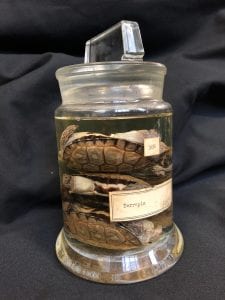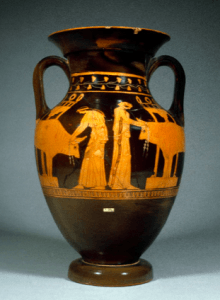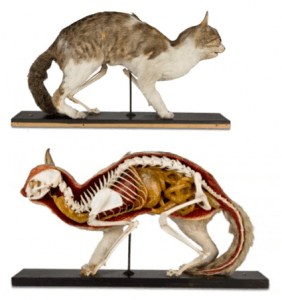[Last modified: March, 25 2019 11:43 AM]
Not all things are remembered after death. Many animate living beings pass away anonymously without any type of ritual or burying. If the memory of a being is never shaped, the potential of immortality and the afterlife cannot occur. But even when we do preserve these beings, how do we do it and what does it mean for the specimen’s journey after death?
Boycotting dissection
In science research, not everybody approves of using dead animals in dissection and observation.
These terrapins (a family of turtles) (1) escaped dissection before being preserved in this glass jar. What is presumed is that an English laboratory, sometime in the 1800s, may have sampled 5 too many turtles and thus jarred them to then donate them. Such a specimen can be used to study the properties of shells or turtles’ inner organs.
Although using animals for science used to not even be questioned, in these past few years, animal rights have become more recognized by individuals and businesses. Many school students withdraw from dissection exercises for emotional reasons; and more and more consumers avoid buying products tested on animals. This trend, reappeared nowadays, actually goes back way farther than we would imagine.
[1] Jar of Emydidae Terrapins
Specimen order: Testudines ; Specimen family: Emydidae
Contained in a glass jar of preserving fluid (80% Industrial Methylated Spirit)
Height: approx. 18 cm
On display at the Grant Museum of Zoology and Comparative Anatomy (London)
Name, Collector, Locality, Donor, Date: unknown
Specimen No. X679 (Order: Testudine) (Family: Emydidae)
Conservation Record No. CR 930
Celebrating animals in their killing
In ancient times, killing animals was not an everyday act. Animal meat was only eaten for celebrations and funerary rites: you had to share with the gods before sharing with your family and friends. Therefore, the act of killing was through sacrificing, a ritual made to appease a deity and sometimes accompany and protect the dead into the afterlife. We can pinpoint their beginnings to early humans who had transitioned their living habits from hunter-gatherer to agriculture and the domestication of animals. Before the start of the sacrifice, the animal was cleaned, dressed up and walked in a procession to the temple altar. The pottery painting of the sacrificial bulls (b) shows the care involved in this ritual. The fact that this ritual was represented crystallizes these animals in collective memory.
Animals were believed to serve a higher purpose. They restored fertility on earth and appeased the entities beyond death, in the afterlife.
[2] Sacrificial bulls amphora
Amphora, painted in black gaze with white on the stemmata and added red for the inscription (Πολύγνωτος, or Nausicaa Painter), circa 450 BC, made in Attica
Two women prepare bulls for sacrifice by adorning them with stemmata (sacrificial fillets)
On display at the British Museum (London)
Height: 44,45 cms
Acquisition date 1846
Old catalogue 755, Vase E284, CVA British Museum 3 III lc Pl. 17,3
Display number: G20a/dc6 ; Registration number 1846,018.1
Killing animals for Study
These rituals completely changed with the rise of Christianity. Jesus’ sacrifice, in the Eucharist – or Holy Communion – replaced the need to sacrifice animals. The first Christians in the Roman Empire started refusing these sacrifices, to show they rejected pagan gods. Gradually, animal sacrifices were abandoned all together. Fast forwarding to the 1900’s, consuming meat became a common custom again and the livestock industry boomed.
In these same times, in Western countries, animal anatomy was becoming well established as a discipline. Animal sacrifice reappeared but under the form of using animal bodies for human progress, in education and research.
With colonization, travellers also brought back taxidermied species from the colonies, to justify their voyages by immortalizing the unknown creatures in lifelike positions. The taxidermy cat (c), a ‘double-preparation specimen’ allows both the preservation of a domestic animal and an object of study to learn more about its inner organs and skeleton. Doublepreps were created as educational tools in the early 20thc, giving us an x-ray view of species that we’re normally unable to see.
[3] Skeletal-taxidermy double preparation of Domestic Cat
Domestic Cat (Felis silvestris catus)
On display at the Horniman Museum (London)
Registration number: 12.57 Natural History
Date collected: before 1912
Provenance (maker & vendor): Schlüter of Halle
How often do people question these practices? Why is it that we treat animal and human remains differently? Obtaining the agreement and consent of a body is not an easy task with humans, making it even more difficult with animals. When language is taken away, communicating consent is almost impossible. On top of that, animals’ lives are often terminated to be preserved before decomposition of the body; as opposed to humans who are conserved after dying of natural causes.
Animal bodies can be used in ways that the, now dead, being had not agreed upon. In the case of human remains where consent is more defined and outlined, it remains a complicated and, at times reprehensible, issue.
Next section: The Fate of One’s Bones: Heads, miracles and science


